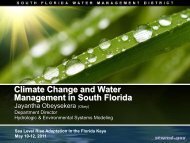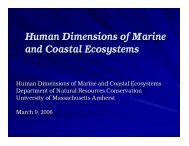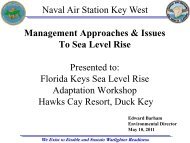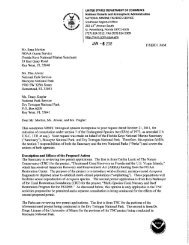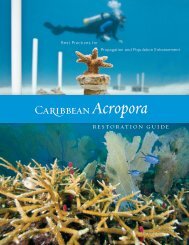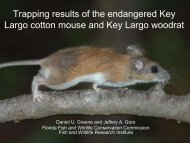Caribbean Acropora Restoration Guide - The Florida Reef ...
Caribbean Acropora Restoration Guide - The Florida Reef ...
Caribbean Acropora Restoration Guide - The Florida Reef ...
Create successful ePaper yourself
Turn your PDF publications into a flip-book with our unique Google optimized e-Paper software.
Outplanting<br />
Goal: Outplant enough nursery-grown colonies from a variety of different donor colonies or genotypes to<br />
enhance the potential for sexual reproduction and recruitment, thereby enhancing the ability of the population<br />
to contribute to its own recovery.<br />
Site Selection<br />
When choosing outplant sites, be sure to do your homework to understand your local area. <strong>The</strong>re are several<br />
factors to consider in site selection which can be key to outplant success or failure.<br />
• Existing Wild Populations: Let the distribution and status of the remaining wild coral population<br />
guide your decision; habitats that harbor healthy <strong>Acropora</strong> populations likely provide adequate<br />
environmental conditions for outplanted colonies.<br />
• Depth: Outplant sites should be similar to the depths of the nursery sites and the existing wild<br />
populations in the area.<br />
• Water Quality: <strong>Acropora</strong> corals require good water quality to thrive, including low sedimentation and<br />
turbidity and relatively minimal temperature fluctuations over daily, monthly or annual time frames.<br />
Extremely high and low temperatures or drastic fluctuations can cause coral mortality.<br />
• Bottom Type: Hard, stable substrate allows for secure attachment of outplants; avoid areas with an<br />
abundance of rubble to prevent damage during storms.<br />
• Size of the Area: <strong>The</strong> size of the outplant site should depend on the number of corals to be<br />
outplanted. Typical spacing of outplanted corals is 0.5–2 m. <strong>The</strong> area chosen for outplanted corals<br />
should allow for adequate spacing to promote coral growth.<br />
• Space Competitors: Organisms that compete for space such as gorgonian canopy, encrusting sponges,<br />
Palythoa and algae should be avoided.<br />
• Predator Abundance: Sites should be evaluated for predator abundance prior to transplantation,<br />
noting the presence of corallivorous snails, fireworms and damselfish. Avoid sites with large<br />
populations of such predators or include predator removal within management plans.<br />
• Wave Exposure: Choose sites with moderate to low energy environments to reduce the risk of<br />
damage to the outplanted corals.<br />
• Origin of Parent Colonies: Unless required or desired for specific restoration goals, outplanting<br />
corals long distances away from collection sites should be avoided.<br />
• Current/Historical presence of <strong>Acropora</strong>: In the absence of surviving <strong>Acropora</strong> populations, outplant<br />
sites should be located where a historical presence of <strong>Acropora</strong> has been noted. In addition, outplant<br />
sites in waters of the United States should be within areas designated “critical <strong>Acropora</strong> habitat” by<br />
NOAA’s National Marine Fisheries Service.<br />
• Human Activities/Impacts: Outplants should be deployed in areas that are remote from human<br />
activities that could damage corals. Areas where human activities are limited such as Marine Protected<br />
Areas (MPAs) are ideal locations for outplants. MPAs also provide an improved trophic structure<br />
with an increased abundance of herbivores such as fish and urchins that may keep algae under control,<br />
as well as abundant predators that may control the abundance of corallivorous snails and worms.<br />
23





